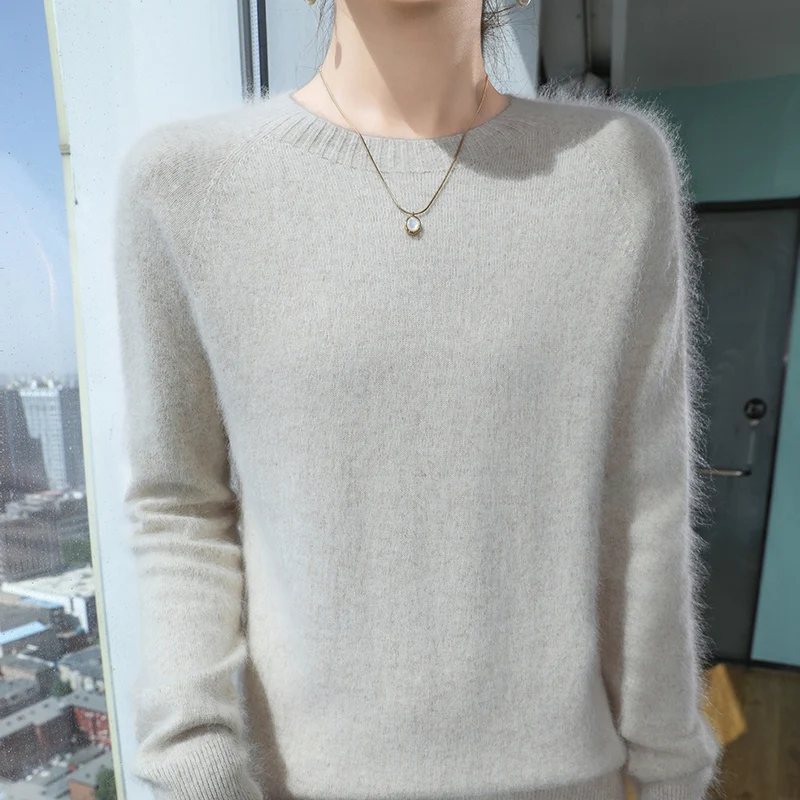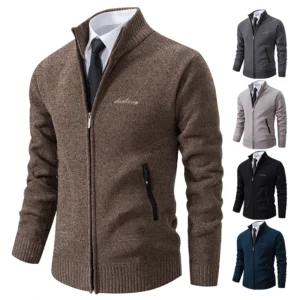Understanding Cashmere Sweater Necklines for Perfect Layering
Layering cashmere sweaters is both a practical skill and an art form. When done correctly, layering creates versatile outfits that adapt to changing temperatures while maintaining a polished, sophisticated appearance. The secret to successful layering often lies in one crucial detail: the neckline.
The neckline you choose serves as the foundation of your layered look, affecting:
– How comfortably different pieces work together
– The overall silhouette and proportion of your outfit
– Which additional garments can be layered effectively
– The level of warmth and temperature regulation
Different necklines create entirely different layering possibilities. Some frame collared shirts perfectly, while others provide clean lines for minimalist styling. Understanding the differences between V-necks and crew necks helps create more intentional, polished outfits.
Premium cashmere is particularly well-suited for layering due to its remarkable temperature-regulating properties. Unlike bulkier materials, fine cashmere provides exceptional warmth without unwanted thickness, making it ideal for creating smooth, elegant layers. The fiber’s natural breathability prevents overheating when moving between different environments.
When planning your layered cashmere looks, consider both inner layering (what goes underneath your sweater) and outer layering (what goes on top). The right neckline choice facilitates both approaches, expanding your cashmere sweater’s versatility across seasons and occasions.
Let’s explore how different neckline styles create distinct layering opportunities and which V-neck and crew neck cashmere sweater options work best for various styling needs.
The Versatile Crew Neck: A Layering Foundation
The crew neck cashmere sweater features a rounded neckline that sits at the base of the neck, creating a clean, classic silhouette. This timeless design has remained popular for decades because it serves as an excellent foundation for numerous layering combinations.
Crew necks excel at creating a polished appearance while maintaining comfort. The higher neckline provides warmth around the neck and creates a smooth canvas for both under and over layering techniques. This traditional style works effortlessly across casual and professional settings.
Best Inner Layers:
– Collared shirts (button-downs, Oxford cloth) with collar points tucked neatly under or slightly peeking out
– Thin turtlenecks for maximum warmth in winter
– Simple crew neck t-shirts for casual comfort
– Silk camisoles (for women’s styling) creating smooth lines
Best Outer Layers:
– Blazers and sport coats for business casual settings
– Denim jackets for relaxed weekend looks
– Quilted vests for outdoorsy layering
– Overcoats and peacoats for winter protection
Styling Tips:
– Keep inner layers slim-fitting to prevent uncomfortable bunching
– For collared shirts, ensure the collar sits flat against the neckline
– Create contrast between layers with complementary colors
– Consider slightly looser crew necks when layering over collared shirts
Layering Pros:
– Universally flattering for most face shapes and body types
– Creates a neat, polished appearance that works across formality levels
– Provides good neck coverage for cooler weather
Layering Cons:
– Can create bulk when worn over thicker shirts
– Limited ability to showcase elaborate collar designs
– Sometimes restricts styling of statement necklaces
The crew neck’s versatility makes it an excellent starting point for those new to layered dressing. For inspiration on different ways to style this classic neckline, explore our collection of crew neck cashmere outfit inspirations featuring versatile looks for various occasions.
Browse our men’s cashmere pullovers collection to discover crew neck options crafted from premium Grade A cashmere fibers.
The Elegant V-Neck: Creating Visual Interest Through Layering
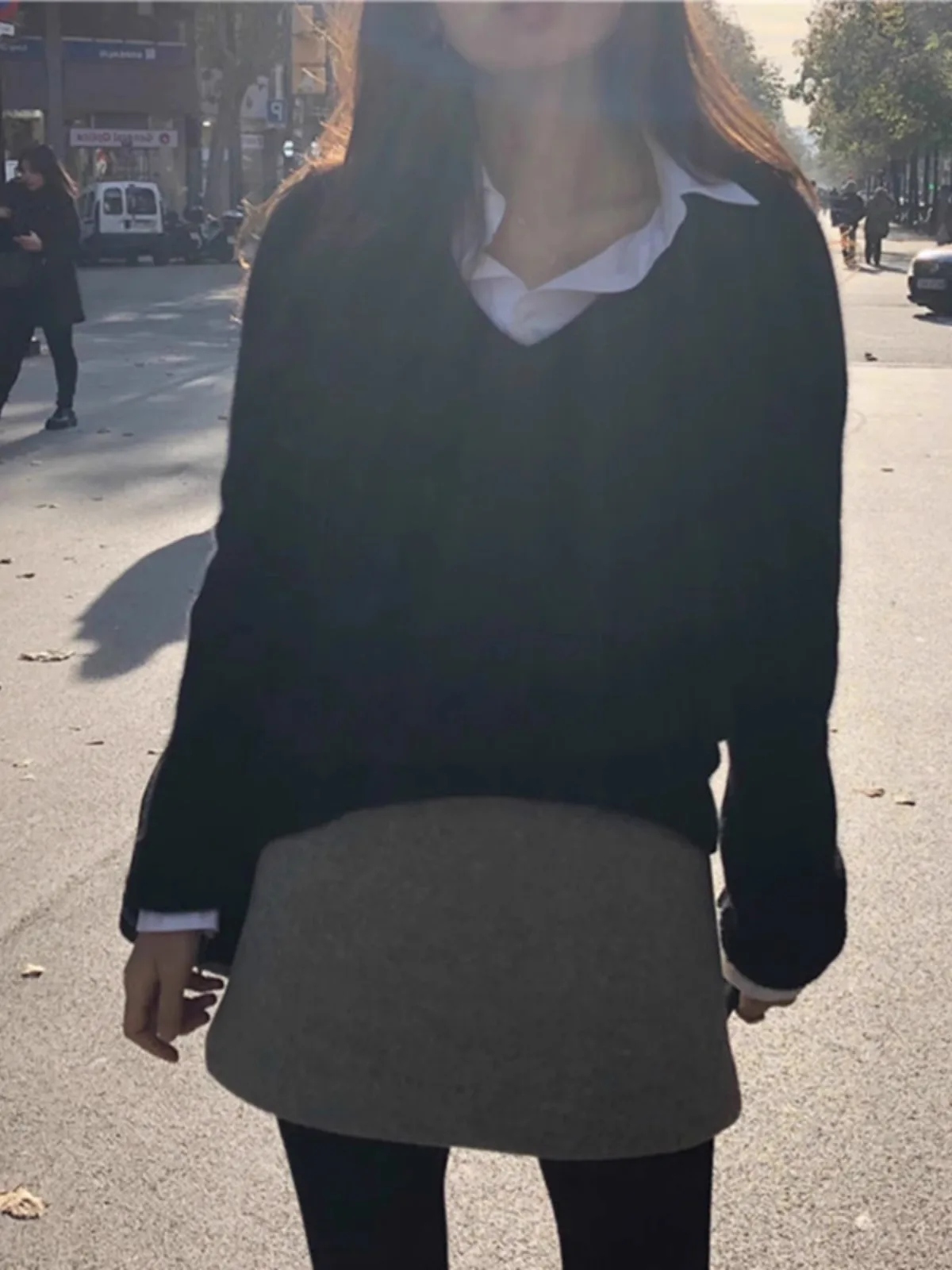
The V-neck cashmere sweater creates a distinctive inverted triangle at the neckline that naturally draws the eye downward, creating a lengthening effect. This elegant neckline was originally designed specifically for layering under suits and has evolved into one of the most versatile layering styles.
V-necks excel at framing and showcasing inner layers. The open space created by the V provides a perfect window to display collared shirts, necklaces, and other visual details. The depth of the V can range from shallow to deep, each offering different styling possibilities.
Best Inner Layers:
– Dress shirts with spread or pointed collars
– Silk or cotton blouses with interesting neckline details
– Lightweight turtlenecks for unexpected contrast
– Mock necks for a modern layered look
– Camisoles and thin tees for casual styling
Best Outer Layers:
– Blazers and suit jackets for professional settings
– Cardigans for a sophisticated sweater-on-sweater approach
– Trench coats and tailored overcoats for refined outerwear
– Lightweight jackets for transitional seasons
Styling Tips:
– Use contrasting collar colors to create visual pop
– Consider the depth of the V when selecting inner layers to avoid over-exposure
– For formal settings, coordinate tie colors with the cashmere V-neck
– For women’s styling, use the V as a frame for delicate necklaces
Layering Pros:
– Creates vertical visual lines that elongate the neck and torso
– Perfectly showcases collared shirts and blouses
– Offers natural breathability and temperature control
– Creates a more formal appearance than crew necks
Layering Cons:
– Requires careful consideration of inner layers to avoid inappropriate exposure
– May require specific undergarments depending on the depth of the V
– Can appear unbalanced with very bulky outer layers
The V-neck’s framing quality makes it particularly effective for creating polished, intentional-looking layers. For more detailed guidance on styling this elegant neckline, visit our guide on how to style V-neck cashmere with various garments.
Explore our collection of women’s V-neck cashmere sweaters featuring premium fibers and timeless designs.
The Sophisticated Turtleneck: Streamlined Layering Appeal
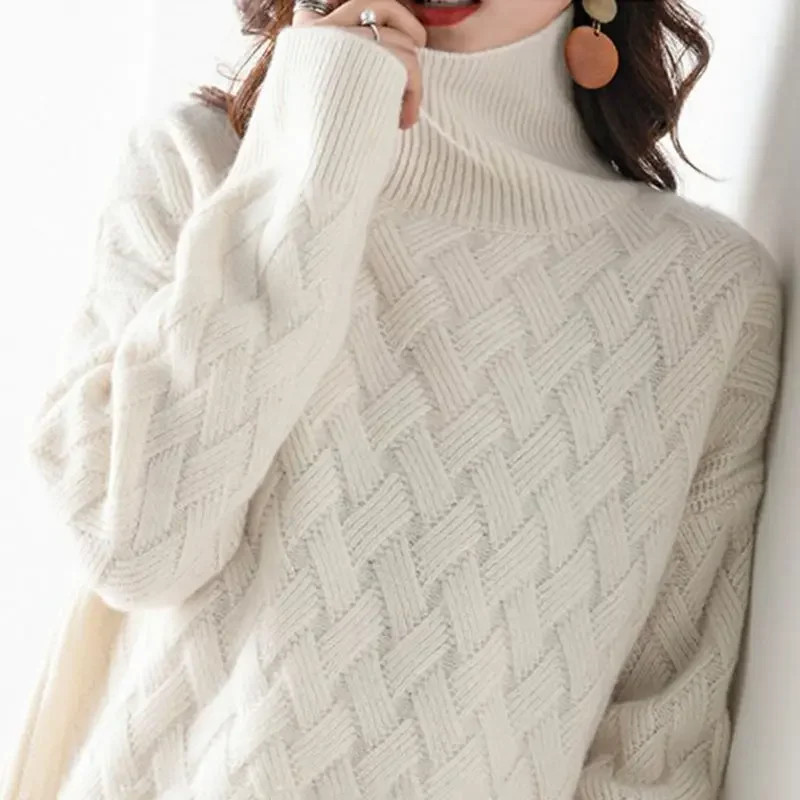
The turtleneck (also called a roll neck) cashmere sweater features a high, folded collar that encircles the neck. This distinctive design creates a sleek, sophisticated silhouette that serves as both a practical warming layer and a statement piece in its own right.
Turtlenecks offer unique layering potential as they can be worn as the innermost layer for warmth or as a middle layer for visual interest. The clean lines created by the high neck provide an elegant foundation for various outerwear options.
Best Inner Layers:
– Very thin silk or merino base layers for additional warmth without bulk
– Nothing at all—turtlenecks often stand alone as the base layer
Best Outer Layers:
– Oversized cardigans for contemporary casual style
– Other sweaters (crew necks, V-necks) for maximum winter warmth
– Blazers and suit jackets for professional elegance
– Camel coats and wool overcoats for classic winter sophistication
– Sleeveless dresses for unexpected layering dimensions
Styling Tips:
– Choose fine-gauge cashmere for the sleekest layering potential
– Experiment with contrasting textures between turtleneck and outer layers
– For shorter necks, opt for slightly lower turtlenecks or fold them down once
– Consider the color carefully—turtlenecks create a visual color block at the face
Layering Pros:
– Provides maximum neck warmth in cold weather
– Creates a streamlined, elegant silhouette
– Eliminates need for scarves in many outfits
– Frames the face beautifully
Layering Cons:
– Can feel restrictive for some wearers
– Sometimes too warm for heated indoor environments
– Limits visibility and use of necklaces and collared inner layers
Turtlenecks offer sophisticated simplicity that works particularly well in professional and formal settings. The streamlined silhouette pairs beautifully with structured outerwear pieces and creates an instantly polished appearance.
Discover our collection of premium cashmere turtlenecks crafted from the finest fibers. For more information on layering thinner cashmere pieces for optimal comfort, read our guide on the benefits of lightweight cashmere layers.
The Adaptable Cardigan: Layering Freedom
Cashmere cardigans represent perhaps the most versatile layering pieces in a well-curated wardrobe. These front-opening sweaters can be buttoned, partially buttoned, or left open, creating multiple styling options from a single garment. Available in both V-neck and crew neck varieties, cardigans offer unmatched layering flexibility.
The unique advantage of cardigans lies in their ability to function as both mid-layers and outer layers. This adaptability makes them particularly valuable for environments with fluctuating temperatures or for transitional seasonal weather.
Best Inner Layers:
– T-shirts and lightweight cotton tops for casual styling
– Silk blouses and button-downs for elevated looks
– Camisoles and tank tops for minimalist approaches
– Fine knit sweaters and turtlenecks for winter layering
Best Outer Layers:
– Structured coats and trench coats (cardigan as mid-layer)
– Blazers for business casual settings (cardigan as mid-layer)
– Utility jackets and denim jackets for weekend wear
Styling Tips:
– Wear fully open for a relaxed, elongating effect
– Button partially for defined waistline and structured appearance
– Choose fitted cardigans for layering under blazers and jackets
– Opt for oversized styles when wearing as an outer layer
Layering Pros:
– Adjustable warmth through buttoning options
– Adds visual dimension through overlapping panels
– Highly adaptable across formality levels
– Creates vertical lines that elongate the silhouette
Layering Cons:
– Can create unwanted bulk with heavier knits
– Sometimes appears less formal than comparable pullovers
– Requires attention to button placement for flattering fit
Cardigans excel at creating depth in otherwise simple outfits. The vertical opening creates natural lines that draw the eye up and down rather than across, often resulting in a slimming visual effect.
Cashmere Wrap Sweaters, Women's Cashmere Pullovers
$75.89 Select options This product has multiple variants. The options may be chosen on the product pageCashmere Cable Knit Sweaters, Women's Cashmere Pullovers
Price range: $111.82 through $112.93 Select options This product has multiple variants. The options may be chosen on the product pageCropped Cashmere Sweaters, Women's Cashmere Pullovers
$155.77 Select options This product has multiple variants. The options may be chosen on the product page- Price range: $102.02 through $109.37 Select options This product has multiple variants. The options may be chosen on the product page
Oversized Cashmere Sweaters, Plus Size Cashmere Sweaters, Women's V-Neck Cashmere Sweaters
$136.87 Select options This product has multiple variants. The options may be chosen on the product page- Price range: $108.11 through $130.03 Select options This product has multiple variants. The options may be chosen on the product page
For additional inspiration on styling cashmere for transitional weather, explore our guide on layering cropped cashmere sweaters for fall featuring modern proportions and styling approaches.
Other Noteworthy Necklines for Specialized Layering
While crew necks, V-necks, turtlenecks and cardigans dominate the cashmere layering conversation, several other neckline styles offer interesting alternatives for specific styling needs:
Boat Neck (Bateau):
– Features a wide neckline that runs horizontally across the collarbone
– Works beautifully with minimalist camisoles or thin tops underneath
– Pairs perfectly with statement earrings rather than necklaces
– Creates an elegant, feminine silhouette particularly flattering for narrow shoulders
– Layer under: Cropped jackets, fitted blazers
– Layer over: Thin cotton tees, sleeveless shells
Scoop Neck:
– Features a U-shaped opening that dips below the collarbone
– Creates perfect framework for showcasing short necklaces and pendants
– Allows for slightly thicker under-layers without bulk
– Provides a more relaxed alternative to crew necks
– Layer under: Denim jackets, cardigans, casual blazers
– Layer over: Collared shirts (lower collars), fitted tees, camisoles
Mock Neck:
– Features a partial turtleneck that stands up but doesn’t fold over
– Provides neck coverage without the bulk of a full turtleneck
– Creates clean lines for layering under jackets and coats
– Offers modern, minimalist aesthetic
– Layer under: Structured blazers, wool coats, leather jackets
– Layer over: Typically worn as the base layer
Henley:
– Features a round neckline with partial button placket
– Adds subtle visual interest when layered under open cardigans
– Creates casual texture when visible beneath sweaters
– Offers adjustable neckline opening
– Layer under: Crew neck sweaters, V-neck sweaters, open cardigans
– Layer over: Basic tees, thin thermal layers
For comprehensive information on various neckline options and their styling potential, explore our ultimate guide to cashmere necklines featuring detailed illustrations and recommendations.
Essential Fabric Considerations for Cashmere Layering
Successful cashmere layering begins with understanding fabric characteristics. The weight, gauge, and composition of your cashmere pieces significantly impact how well they function in layered outfits.
Premium cashmere, like that used by Estate Cloth, offers exceptional layering performance due to its fine fibers (under 16 microns) and longer staple length (exceeding 36mm). These characteristics create garments with natural temperature regulation, breathability, and minimal bulk—all essential qualities for comfortable, elegant layering.
When planning layered cashmere outfits, consider these important fabric factors:
- Gauge matters significantly: Fine-gauge knits (12-gauge and higher) provide versatility for both under and over layering, while heavier gauges work best as outer layers
- Prioritize compatible fabrics: Natural fibers generally layer more harmoniously together—silk, cotton, fine wool, and linen complement cashmere beautifully
- Consider breathability: Layer breathable fabrics to prevent overheating and discomfort
- Weight distribution: Place lighter fabrics closest to the body and gradually increase weight moving outward
- Avoid friction-prone combinations: Some fabric pairings create static or friction that can damage cashmere fibers or cause pilling
Understanding the differences between fine and heavy gauge cashmere helps you select the most appropriate pieces for your specific layering needs. Fine-gauge cashmere typically offers greater versatility across seasons, while heavier gauges provide substantial warmth during winter months.
Mastering Fit and Proportions in Layered Cashmere Outfits
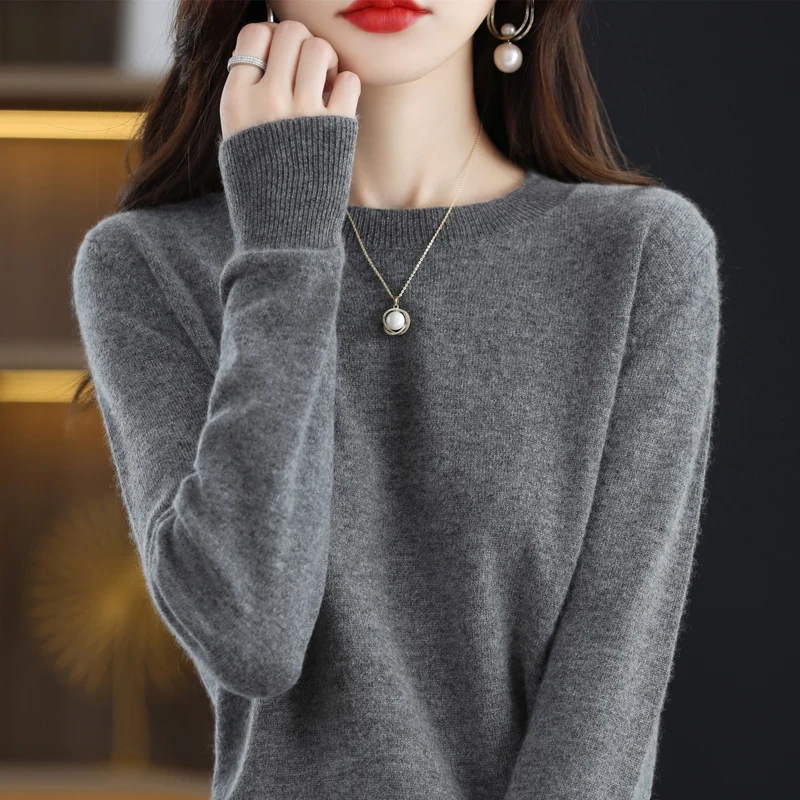
The difference between an elegant layered outfit and a bulky, uncomfortable one often comes down to fit and proportions. Mastering these elements ensures your cashmere layers work harmoniously together.
When layering cashmere sweaters, remember these essential fit principles:
- Inner layers should be thin and fitted to prevent bunching
- Allow approximately ½ inch of sleeve from inner layers to show at wrists
- For collared shirts under sweaters, ensure collar points stay neatly beneath the sweater or sit flat against it
- When purchasing specifically for layering, consider sizing up in outer layers
- Create intentional length differences between layers (typically 1-2 inches) for visual interest
Proper proportions help create balanced, flattering silhouettes:
- Balance voluminous tops with slimmer bottoms and vice versa
- Consider your body type when selecting necklines for layering
- Ensure cashmere sweaters maintain their proper drape without stretching
- Create visual harmony through intentional overlapping of lengths
Finding the most flattering necklines for your body type can significantly enhance your layered looks. The right neckline not only complements your features but also creates the most harmonious foundation for additional layers.
Strategic Color and Texture Play in Cashmere Layering
Thoughtful color and texture combinations elevate layered cashmere outfits from basic to sophisticated. These elements add visual interest and dimension to what might otherwise be simple looks.
When planning your color strategy for layered cashmere outfits:
- Consider monochromatic layers in varying shades of the same color for subtle elegance
- Create intentional contrast with complementary colors between visible layers
- Use neutral cashmere as a versatile canvas for colorful under or over layers
- Apply the rule of three: limit your palette to three coordinating colors for cohesiveness
Texture combinations add depth and visual interest:
- Pair smooth, fine-gauge cashmere with crisp cotton shirts
- Contrast ribbed cashmere with silky fabrics
- Mix matte and lustrous textures for dimension
- Consider cable knits as statement layers with simpler pieces
These principles apply across various settings, from casual to formal. For specific examples of color coordination in professional environments, explore our guide to creating professional looks with cashmere sweaters.
Seasonal Adaptability: Layering Cashmere Year-Round
Cashmere’s reputation as exclusively winter wear is outdated. Modern fine-gauge cashmere offers remarkable versatility across seasons, making it an ideal investment for year-round layering strategies.
Winter Layering:
– Maximize warmth with multiple thin layers rather than one thick layer
– Combine turtlenecks under crew necks for extreme cold
– Add cashmere cardigans as mid-layers between base layers and outerwear
– Use cashmere scarves as additional neck protection with various necklines
Spring/Fall Transitional Layering:
– Employ lightweight cashmere as temperature-regulating outer layers
– Layer V-neck cashmere over light cotton shirts for adaptable warmth
– Use cardigans as easy-to-remove outer layers for fluctuating temperatures
– Combine short-sleeve cashmere with longer underneath layers
Summer Evening Layering:
– Drape lightweight cashmere cardigans over summer dresses
– Use fine-gauge V-necks as elegant evening cover-ups
– Pack thin cashmere for air-conditioned environments
– Consider cashmere-silk blends for the lightest warm-weather options
For more detailed guidance on adapting cashmere to warmer months, read our spring cashmere layering guide with specific outfit formulas and styling tips.
Common Layering Mistakes to Avoid with Cashmere
Even with premium cashmere pieces, certain layering missteps can undermine both comfort and style. Being aware of these common errors helps create more successful layered outfits.
Mistake: Creating Excessive Bulk
Problem: Too many layers or incompatible thicknesses create uncomfortable bunching and unflattering silhouettes.
Solution: Focus on thin, strategic layers rather than numerous thick ones. Choose fine-gauge cashmere for inner and mid-layers.
Mistake: Neckline Clashes
Problem: Competing necklines create visual confusion and uncomfortable fit issues.
Solution: Ensure necklines either harmoniously frame each other (like V-necks over crew necks) or cleanly overlay without awkward gaps or bunching.
Mistake: Ignoring Sleeve Proportions
Problem: Mismatched sleeve lengths create uncomfortable bunching at wrists and elbows.
Solution: Layer from shortest to longest sleeves moving outward, or create intentional “showing” of inner layer cuffs.
Mistake: Overlooking Static Potential
Problem: Some fabric combinations with cashmere create uncomfortable static cling.
Solution: Use anti-static sprays on inner layers or choose natural fibers that reduce static build-up.
Mistake: Neglecting Practical Movement
Problem: Beautiful layers that restrict movement or constantly need readjustment.
Solution: Test your range of motion in layered outfits before wearing them for extended periods.
Quality cashmere construction, like that found in Estate Cloth pieces, helps avoid many common layering issues through proper design and finishing techniques.
Inspirational Layered Cashmere Outfit Ideas by Occasion
Apply the neckline layering principles to create polished looks for various settings:
Office Elegance:
– V-neck cashmere sweater over a crisp white button-down with the collar peeking out
– Add tailored blazer and wool trousers
– Finish with leather accessories and minimal jewelry
– Perfect necklines: V-neck, shallow crew neck
Weekend Casual:
– Crew neck cashmere over a simple cotton t-shirt
– Pair with premium dark denim jeans
– Add casual leather sneakers or loafers
– Layer with utility jacket or denim jacket as needed
– Perfect necklines: Crew neck, henley
Evening Sophistication:
– Fine-gauge cashmere turtleneck as a standalone piece or under a sleeveless dress
– Pair with tailored pants or a midi skirt
– Add statement earrings (skip necklaces with turtlenecks)
– Perfect necklines: Turtleneck, mock neck
Smart Casual Events:
– Open cashmere cardigan over a silk blouse or fine cotton shirt
– Pair with slim-fit pants or dark jeans
– Add leather flats or minimalist heels
– Perfect necklines: V-neck cardigan, boat neck
Outdoor Adventures:
– Layer technical base layer under lightweight cashmere crew neck
– Add water-resistant outerwear appropriate to conditions
– Pair with performance bottoms and sturdy footwear
– Perfect necklines: Crew neck, quarter-zip
Care Tips for Maintaining Layered Cashmere
Layering cashmere actually offers care advantages when done correctly. Inner layers protect cashmere from direct skin contact, while outer layers shield it from environmental damage. This strategic approach can extend the life of your premium pieces.
Proper care for layered cashmere includes:
- Allow cashmere to rest 24-48 hours between wearings to regain shape
- Store layering pieces flat rather than hanging to prevent stretching
- Spot clean outer cashmere layers rather than washing after every wear
- Use garment brushes to refresh cashmere between cleanings
- Protect lighter colored cashmere from potential dye transfer from darker layers
- Consider collar protectors for makeup transfer zones
Estate Cloth’s rigorous 12-point quality control process ensures exceptional durability in their cashmere pieces, including superior pilling resistance and colorfastness—particularly important qualities for garments used frequently in layered outfits.
For comprehensive cashmere care instructions, reference our guide on the best way to clean cashmere sweaters to maintain their luxurious feel and appearance.
Are Certain Necklines Better for Specific Body Types When Layering?
Different necklines naturally complement various body types and facial features, creating more harmonious and flattering layered looks.
For Round or Full Faces:
– V-necks create elongating vertical lines
– Deep scoop necks draw the eye downward
– Avoid high turtlenecks which can emphasize facial roundness
– Cardigans left open create slimming vertical lines
For Long or Narrow Faces:
– Crew necks and boat necks add horizontal balance
– Turtlenecks complement by continuing the vertical line
– Avoid very deep V-necks which can further elongate
For Shorter Necks:
– V-necks create the illusion of a longer neck
– Avoid true turtlenecks in favor of mock necks
– Open cardigans create vertical lines that elongate
For Longer Necks:
– Turtlenecks and higher crew necks provide balanced proportions
– Boat necks add horizontal dimension
– Layer with shorter necklaces to break the vertical line
For Petite Frames:
– Avoid overwhelming necklines like very wide boat necks
– Choose proportionally sized V-necks that don’t dip too low
– Consider cardigans for creating vertical visual lines
For Taller Frames:
– Boat necks and wider crew necks add horizontal balance
– Layer with chunky scarves to create proportion
– Experiment with dramatic turtlenecks that complement height
For more detailed guidance on selecting the most flattering necklines for different body proportions, explore our guide to flattering necklines for body type.
Is It Possible to Layer Multiple Cashmere Pieces Together?
Layering cashmere with cashmere creates luxurious comfort and visual interest when done correctly. This approach maximizes the material’s natural temperature-regulating properties while creating sophisticated texture.
Successful cashmere-on-cashmere layering depends on:
- Varying weights: Combine fine-gauge pieces with heavier knits
- Contrasting textures: Pair ribbed cashmere with smooth finishes
- Strategic color selection: Use tonal variations or complementary colors
- Thoughtful silhouettes: Layer looser pieces over fitted ones
Effective cashmere-on-cashmere combinations include:
– Thin cashmere tee under cashmere cardigan
– Cashmere turtleneck under cashmere crew neck for extreme cold
– Cashmere dress with cashmere cardigan
– Cashmere shell under cashmere blazer
To manage potential static between cashmere layers, consider using fabric softener sheets or anti-static spray on the inner layer, or introduce a silk layer between cashmere pieces.
What Makes Cashmere Particularly Suitable for Layering Compared to Other Knits?
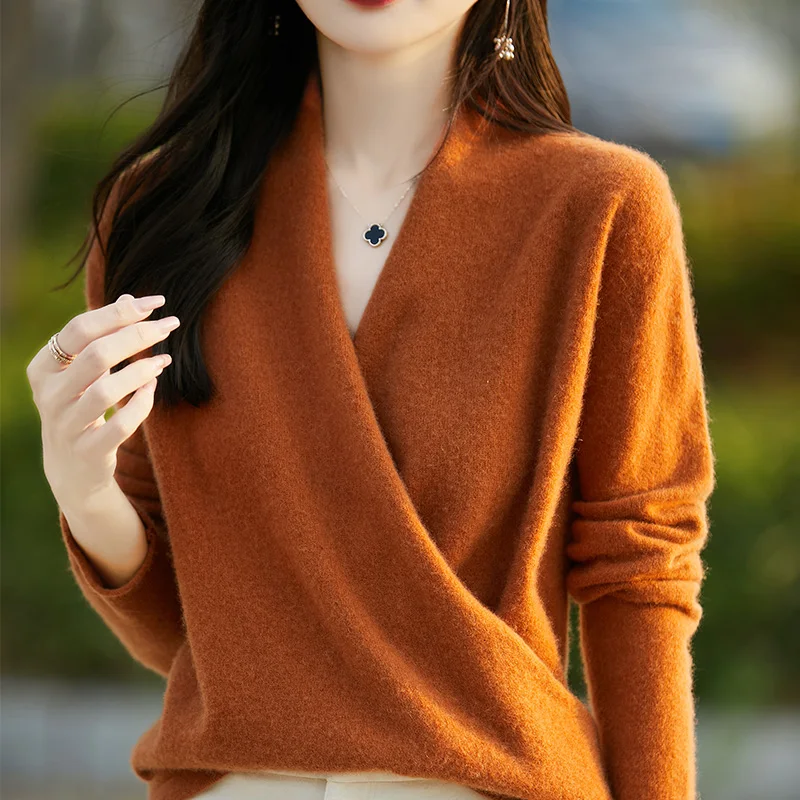
Cashmere possesses unique physical properties that make it exceptionally well-suited for layering compared to other knit materials:
Superior Warmth-to-Weight Ratio:
Cashmere provides approximately three times more insulation than regular wool at a fraction of the weight. This allows for maximum warmth without the bulk that makes layering difficult.
Natural Temperature Regulation:
Unlike synthetic fibers that can trap heat uncomfortably, cashmere fibers naturally adapt to body temperature, releasing excess heat to prevent overheating even when layered.
Exceptional Softness:
Premium cashmere fibers (under 16 microns in thickness) create a remarkably soft hand-feel that reduces friction between layers, preventing the “stuck” or bunched feeling common with other materials.
Natural Elasticity:
Quality cashmere maintains its shape throughout the day, preventing the sagging and stretching that can ruin carefully planned layered looks.
Breathability:
Cashmere allows air circulation even in multiple layers, preventing the clammy feeling often experienced with synthetic knits.
Estate Cloth’s Grade A cashmere, with fibers exceeding 36mm in length, demonstrates these qualities at the highest level. The longer fiber length contributes to exceptional durability and reduced pilling—crucial qualities for pieces that experience the friction of regular layering.
While the initial investment in quality cashmere may be higher than other knits, its superior layering performance and longevity make it a wise choice for versatile wardrobe building.

